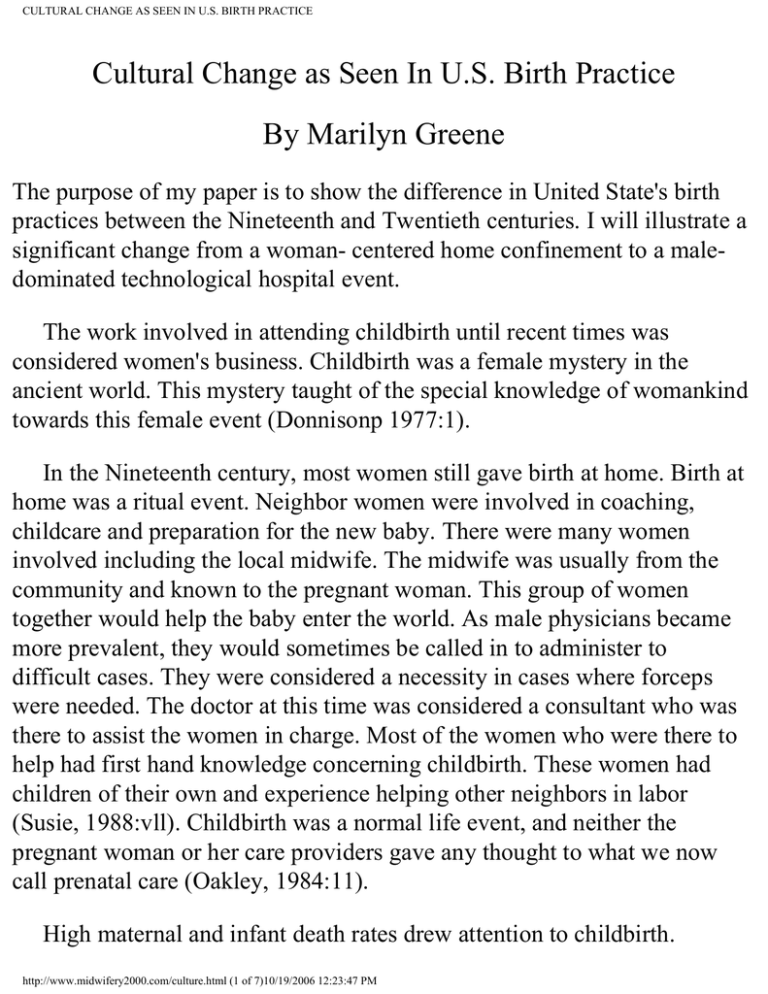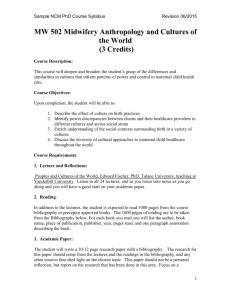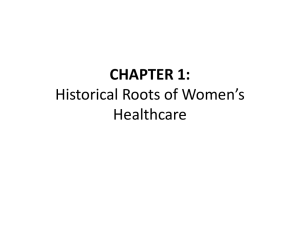Cultural Change as Seen In U.S. Birth Practice By Marilyn Greene
advertisement

CULTURAL CHANGE AS SEEN IN U.S. BIRTH PRACTICE Cultural Change as Seen In U.S. Birth Practice By Marilyn Greene The purpose of my paper is to show the difference in United State's birth practices between the Nineteenth and Twentieth centuries. I will illustrate a significant change from a woman- centered home confinement to a maledominated technological hospital event. The work involved in attending childbirth until recent times was considered women's business. Childbirth was a female mystery in the ancient world. This mystery taught of the special knowledge of womankind towards this female event (Donnisonp 1977:1). In the Nineteenth century, most women still gave birth at home. Birth at home was a ritual event. Neighbor women were involved in coaching, childcare and preparation for the new baby. There were many women involved including the local midwife. The midwife was usually from the community and known to the pregnant woman. This group of women together would help the baby enter the world. As male physicians became more prevalent, they would sometimes be called in to administer to difficult cases. They were considered a necessity in cases where forceps were needed. The doctor at this time was considered a consultant who was there to assist the women in charge. Most of the women who were there to help had first hand knowledge concerning childbirth. These women had children of their own and experience helping other neighbors in labor (Susie, 1988:vll). Childbirth was a normal life event, and neither the pregnant woman or her care providers gave any thought to what we now call prenatal care (Oakley, 1984:11). High maternal and infant death rates drew attention to childbirth. http://www.midwifery2000.com/culture.html (1 of 7)10/19/2006 12:23:47 PM CULTURAL CHANGE AS SEEN IN U.S. BIRTH PRACTICE Poverty, lack of prenatal care and the limitations of the birth attendant were several of the many complex factors that contributed to these high rates (Litoff, 1986:8). Being both articulate and well organized, male physicians easily convinced the American public of what came to be known as "the midwife problem". According to the new male physicians, childbirth became a complicated medical condition that required a specially trained medical doctor (Litoff, Ibid:9). Gradually the domain of childbirth was being taken over by men. The position of men over women was already well established in society. Men had access to education and higher status than women. The introduction of the forceps was a boost to the male practitioner because traditionally custom did not allow midwives to use them (Oakley, 1984:22). Increasing numbers of childbearing women were searching for a safer experience. As they turned to male physicians in greater numbers, the maternal and infant mortality rates remained high. New problems arose from the new "scientific" obstetrics. Complications from the overuse of forceps and the spread of infections such as puerperal fevers traveled with the doctors as they went from deathbed to childbirth. Anesthesia, through which the doctors promised women painless childbirth, was a mixed blessing. Deceleration of labor and breathing disorders were common due to unknowledgable and careless administration (Litoff, 1986:5). The midwife became the symbol of the old, outdated, home confinement. In reaction to the physicians slur campaign against the midwives, Dr. J.D. Mason of the Maryland State Bureau of Child Hygiene had this to say, "It is a little presumptuous for even well-qualified obstetricians to condemn midwives in general when our experience the world over is that in those countries in which midwives play the largest part in obstetric practice there is the lowest maternal mortality" (Susie, 1988:2). http://www.midwifery2000.com/culture.html (2 of 7)10/19/2006 12:23:47 PM CULTURAL CHANGE AS SEEN IN U.S. BIRTH PRACTICE In 1930 the White House Conference on Child Health and Protection concluded that "It seems possible that all advances in medical knowledge have been lost to the parturient woman through too great a recourse to instrumental delivery" (Litoff, Op. cit:6). None of these findings seemed to be able to stop the march towards the commercialization of childbirth. The importance of the individual person or craftsman was becoming lost to the new technology of mass production. The natural course of labor was seen as too long and unfashionably slow. The midwife as craftswoman was sacrificed as society's emphasis was placed on efficiency and time savings (Susie, Op. cit:3). State by state midwifery became regulated. This regulation effectively reduced and attempted to destroy the profession through a three-phase plan of education, licensing and elimination (Susie, Op. cit:6). The demise of the midwife was also the end of a woman's choice. Women who resisted the industrialization of birth now had no alternative other than hospitalization and submission to the doctors and staff. Leaving their homes, family and friends behind, they were forced into an alien environment with strangers invading very private parts of their anatomy. The move to the hospital can be seen as the final triumph in placing childbirth within the sphere of technology. It facilitated its function as an assembly-line procedure for the efficient production of goods, the baby. The mother, instead of being an important participant and decision maker at home, becomes a defective machine, dependent on technology to deliver her child. This same technology is seen as protecting her child from her body. American society uses routine obstetric ritual procedures to mold all childbearing women into conformity (Angeloni, 1989:163). Upon entering the hospital the woman has her autonomy, individuality http://www.midwifery2000.com/culture.html (3 of 7)10/19/2006 12:23:47 PM CULTURAL CHANGE AS SEEN IN U.S. BIRTH PRACTICE and sexuality symbolically removed. This is done by what is known as the "prep". Her clothing, jewelry and belongings are removed, and her body is subjected to selective shaving. The enema is the humiliation at the conclusion of the prep. She is now totally dependent on the institution. It is no longer clear whether she is giving life or the institution is giving life (Angeloni, Ibid:165). Peter Kozlowski, M.D. has said, "There was a set, established routine for doing things, usually for the convenience of the doctors and nurses, and the laboring woman was someone you worked around, rather than with." Through the takeover of midwifery by obstetrics, a discouragement of natural childbirth occurred. This created a loss of the baseline of normality by which we judge abnormality (Towler, 299 ). It was now possible to manipulate nature. In the 1600's, Descartes, Bacon, Hobbes and others assumed that the universe was mechanistic, following predictable laws. Dependence on nature could be minimized through science and manipulated by technology. The body was seen as a machine with the male body as the prototype. Abnormal, defective and dangerously under the influence of nature the female body was seen as in need of constant manipulation by men. Founded on the principles of patriarchy and institutional supremacy the hospital became the American bastion of science and technological intervention (Angeloni, 1989:164). The internal fetal monitor is a key symbol of this technology. The baby is protected from the dangers of the mother by screwing electrodes into its scalp and keeping it attached to a machine (Angeloni, Ibid:165). The use of the monitor has lead to a large increase in operative delivery with no overall decrease in infant mortality. It has also caused a feeling of alienation in some women. One woman expressed this feeling by saying "As soon as I got hooked up to the monitor, all everyone did was stare at it. The nurses didn't even look at me anymore, when they came into the roomhttp://www.midwifery2000.com/culture.html (4 of 7)10/19/2006 12:23:47 PM CULTURAL CHANGE AS SEEN IN U.S. BIRTH PRACTICE they went straight to the monitor. I got the weirdest feeling that it was having the baby, not me" (Angeloni, 1989:166). This feeling applies especially to the poor woman who goes through the public hospital clinic and has to take what society chooses to give. Ability to pay affords some women with limited choices by employment of private obstetricians, but often this goes hand in hand with increased testing and procedures (Angeloni, Ibid:163). It is today in the cultural arena of birth that a visible battle is being fought. Increasing control over the birth process is being sought by obstetricians and institutions. Through increased testing, monitoring and use of Cesarean delivery, a greater reliance on technology and control is created. More women are waking up to the change that has occurred and are seeking to return to a system that gives them greater individuality and self-responsibility. The direction that society takes in childbirth is an indicator of our values. Does society want continued and increased control of human reproduction by institutions? Or will society choose to return to a respect for a well-designed natural process? Birth in the United States is at a crossroads. The truth about what really happened in the past is being revealed to women from a female perspective through feminist scholarship. Technological birthing has now been around long enough that we can judge its good features alongside its bad ones. We have seen a change occur. A change of location, styles and gender has impacted American childbirth practices. Only time can tell if this is a cyclical change or one that is long lasting and permanent. I do not feel that either going nostalgically back to the past or blindly forward to the future is the answer that American women will choose. A new system that combines the positive elements of both ways could emerge. This system could take many things into account such as safety and human dignity. If all women are seen as individuals instead of assembly line producers, our http://www.midwifery2000.com/culture.html (5 of 7)10/19/2006 12:23:47 PM CULTURAL CHANGE AS SEEN IN U.S. BIRTH PRACTICE whole society could benefit. A heightened sense of self-esteem and wellbeing is displayed by an aware, fulfilled mother. This woman enters motherhood with emotions that are positive and loving (Angeloni, 1989:301). Our society can use all the well-adjusted, positive, loving people that we can produce. Works cited: Angeloni, Elvio. Anthropology 89/90. Connecticut: The Duskin Publishing Group. Donnison, Jean. Midwives and Medical Men. New York: Schoken Books, 1977 Litoff, Judy. The American Midwife Debate. Connecticut: Greenwood Press, 1986 Oakley, Ann. The Captured Womb. New York: Basil Blackwell Inc., 1984. Susie, Debra Ann. In the Way of Our Grandmothers. Georgia: The University of Georgia Press, 1988. http://www.midwifery2000.com/culture.html (6 of 7)10/19/2006 12:23:47 PM CULTURAL CHANGE AS SEEN IN U.S. BIRTH PRACTICE Towler, Jean, and Joan Bramall. Midwives in History and Society. New Hampshire: Croom Helm, 1986. http://www.midwifery2000.com/culture.html (7 of 7)10/19/2006 12:23:47 PM



